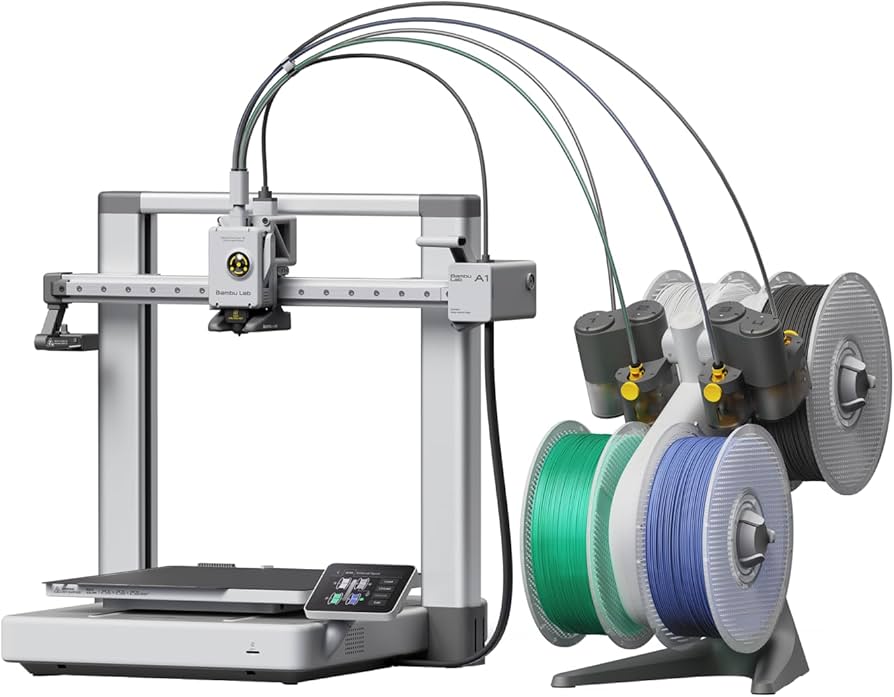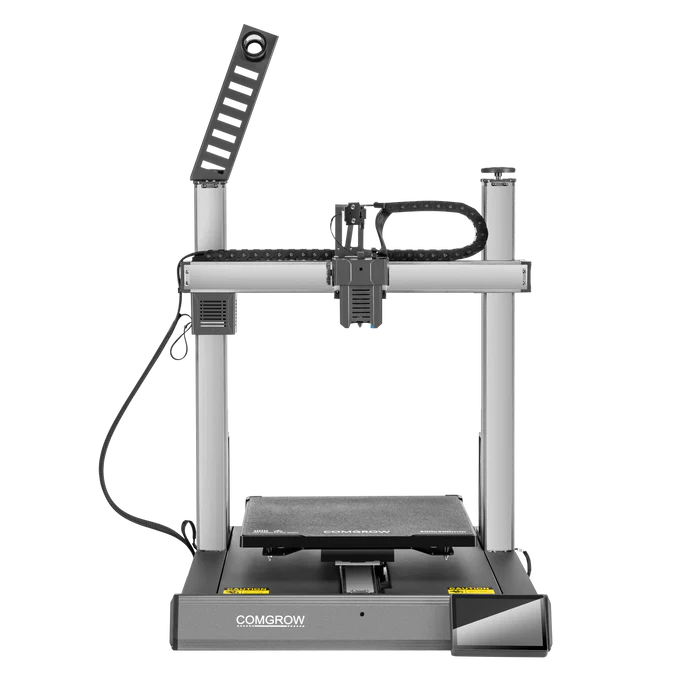Compare A1 vs Comgrow T300
Comparison between the best 3D printers
Choose the best 3D printer at the best price. The cheapest 3D printers are here.
Buy a 3D printer here with 3D Fila.
 |
 |
|
| Model | A1[BUY A1] |
Comgrow T300 |
| Printing Material | Filament | Filament |
| Buy Filament for Bambu Lab A1 | Buy Filament forSovol Comgrow T300 | |
| Estimated price | $700,00 | $449,00 |
| Manufacturer | Bambu Lab | Sovol |
| Release Year | 2023 | 2024 |
| Print Volume [mm] | 256x256x256 | 300x300x350 |
| Printer Size [mm] | 385x410x430 | 503x631x831 |
| Weight [kg] | 8,3 | 17 |
| Power Loss Recovery | YES | YES |
| Enclosed printer | NO | NO |
| Bed Leveling | Automatic | Automatic |
| Filament End Sensor | YES | YES |
| Bed type | Heated | Heated |
| Power supply system | Direct Drive | Direct Drive |
| Standard nozzle | 0,4 | 0,4 |
| Maximum Nozzle Temperature [°C] | 300 | 300 |
| Maximum Bed Temperature [°C] | 100 | 100 |
| Maximum printing speed [mm/s] | 500 | 600 |
| Filament holder | YES | YES |
| Camera for supervision | YES | YES |
| Recommended filaments | PLA, PETG, TPU, PVA | PLA, PETG, PET, TPU, PA, ASA, PC, PLA CE, PA-CF, PET-CF |
| Recommended slicers | SuperSlicer, PrusaSlicer, Cura, OrcaSlicer | Bambu Studio, Super Slicer, Cura, Prusa Slicer, Orca Slicer |
| Maximum Resolution [mm] | 0,1 | 0,1 |
| Processor | 64 bit | |
| Display | Touchscreen 3,5 | Touchscreen 5'' |
| Power Supply | 350 W | 150 W |
| Connectivity | Wi-Fi, Bambu-Bus, Cartão Micro SD | USB, WiFi |
| Operating systems | Windows, Linux, Macbook | Windows, Linux, Macbook |
| Date of registration in the system | 2024-07-17 | 2024-05-10 |
| Release date | 2023 | 2024 |
| Extra features | The BambuLab A1 printer features fully automatic calibration, multi-color printing with the AMS system, active flow rate compensation, quick nozzle change with a clip, active motor noise cancellation, a build volume of 256x256x256 mm³, a maximum extruder temperature of 300°C, and a heated bed of up to 100°C. In addition, it has high precision, a machine health management system and an intuitive 3.5-inch touchscreen interface. | The Sovol Comgrow T300 printer stands out for its technological innovations and advanced features. With a print size of 300mm300mm350mm, the T300 offers true linear rails on all axes, ensuring greater stability. Its Klipper-based intelligent core and 64-bit microcomputer increase printing speed and quality through pressure advancement and input shaping. The extruder with a gear ratio of 6.5:1 allows for more precise material control, optimizing the printing of flexible materials. In addition, the T300 features a rapid filament cooling system with a high-speed fan and a circular duct piece that improves cooling efficiency. With a 4.3-inch high-refresh rate touchscreen and an 81-point automatic leveling system, the T300 simplifies the preparation and execution of 3D prints. |
| Support for multiple colors and materials (AMS and CFS) | YES | NO |
Notes * |
||
| Cost-benefit | 7 / 10 | 8 / 10 |
| Hardware | 4.8 / 10 | 3.6 / 10 |
| Tela | . | . |
| Print volume | 4 / 10 | 4 / 10 |
| Performance | 4 / 10 | 5 / 10 |
| [BUY A1] |
Conclusion |
| In comparing the Bambu Lab A1 and the Sovol Comgrow T300 3D printers, several factors emerge that will help potential buyers make an informed decision. Both models feature automatic bed leveling, power loss recovery, and an array of connectivity options, suggesting they are user-friendly and designed for uninterrupted operation. The Bambu Lab A1 is positioned as a slightly more premium option with advanced features such as multi-color printing support and active motor noise cancellation. It also boasts a higher maximum printing speed, making it appealing for those prioritizing performance and efficiency. Additionally, the A1's smaller form factor and lighter weight may suit users with limited space or who require portability. On the other hand, the Sovol Comgrow T300 excels in its larger print volume and innovative engineering features, such as true linear rails for increased stability and a specialized cooling system for improved print quality. Its Klipper-based control system and optimized gear ratio in the extruder may offer refined control especially for flexible materials. The larger touchscreen interface can enhance user experience, particularly for those who appreciate a more tactile interaction. Despite the price difference, both printers demonstrate solid cost-benefit ratios, with comparable overall hardware scores. While the A1 benefits from some modern features and a robust ecosystem, the T300 may appeal to users needing higher versatility in terms of materials and print sizes. Ultimately, the decision between the two models should hinge on the user’s specific needs—be it speed and advanced features with the A1 or size and material versatility with the T300. Both deliver excellent value propositions in the current 3D printing landscape. |

